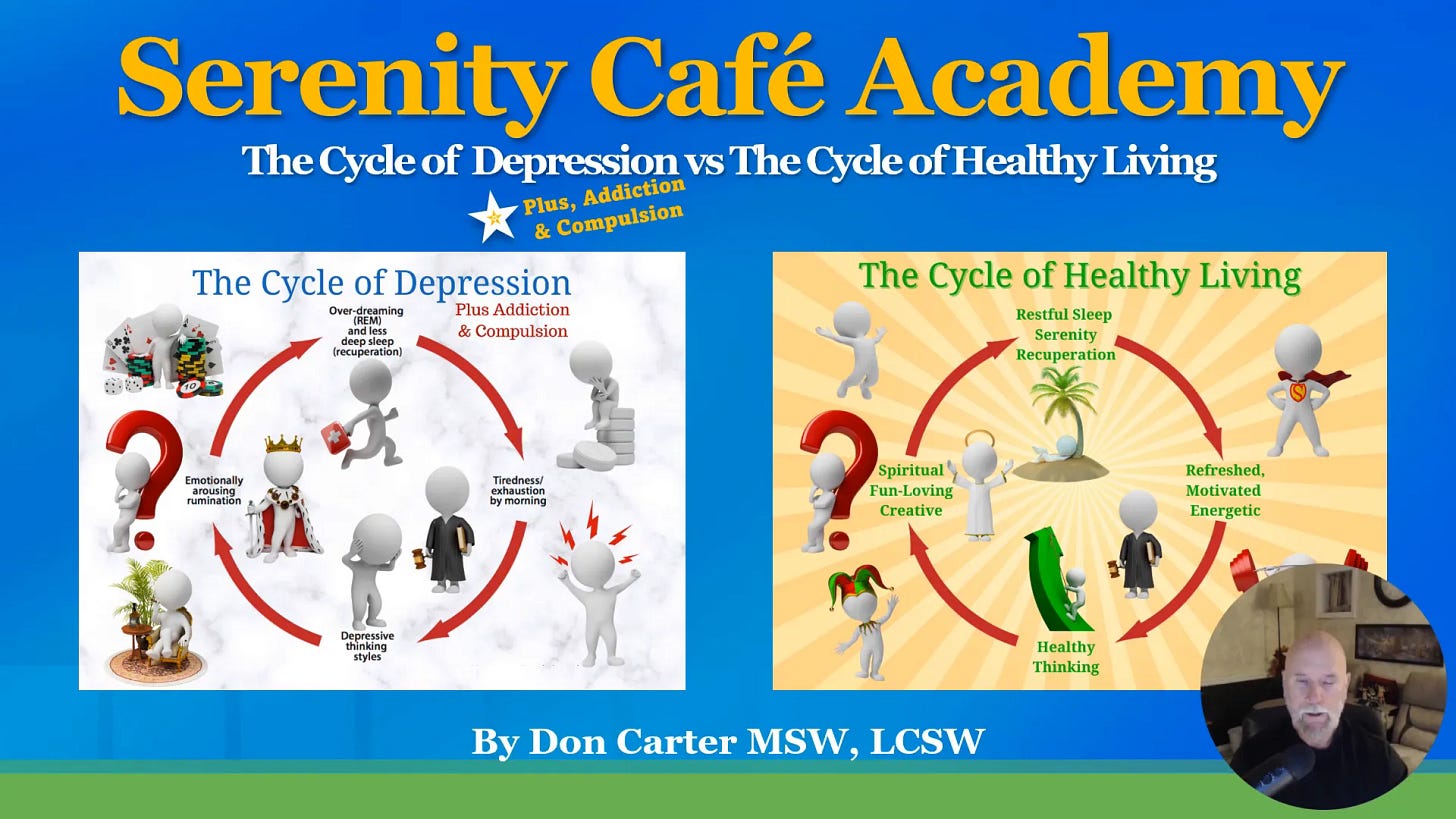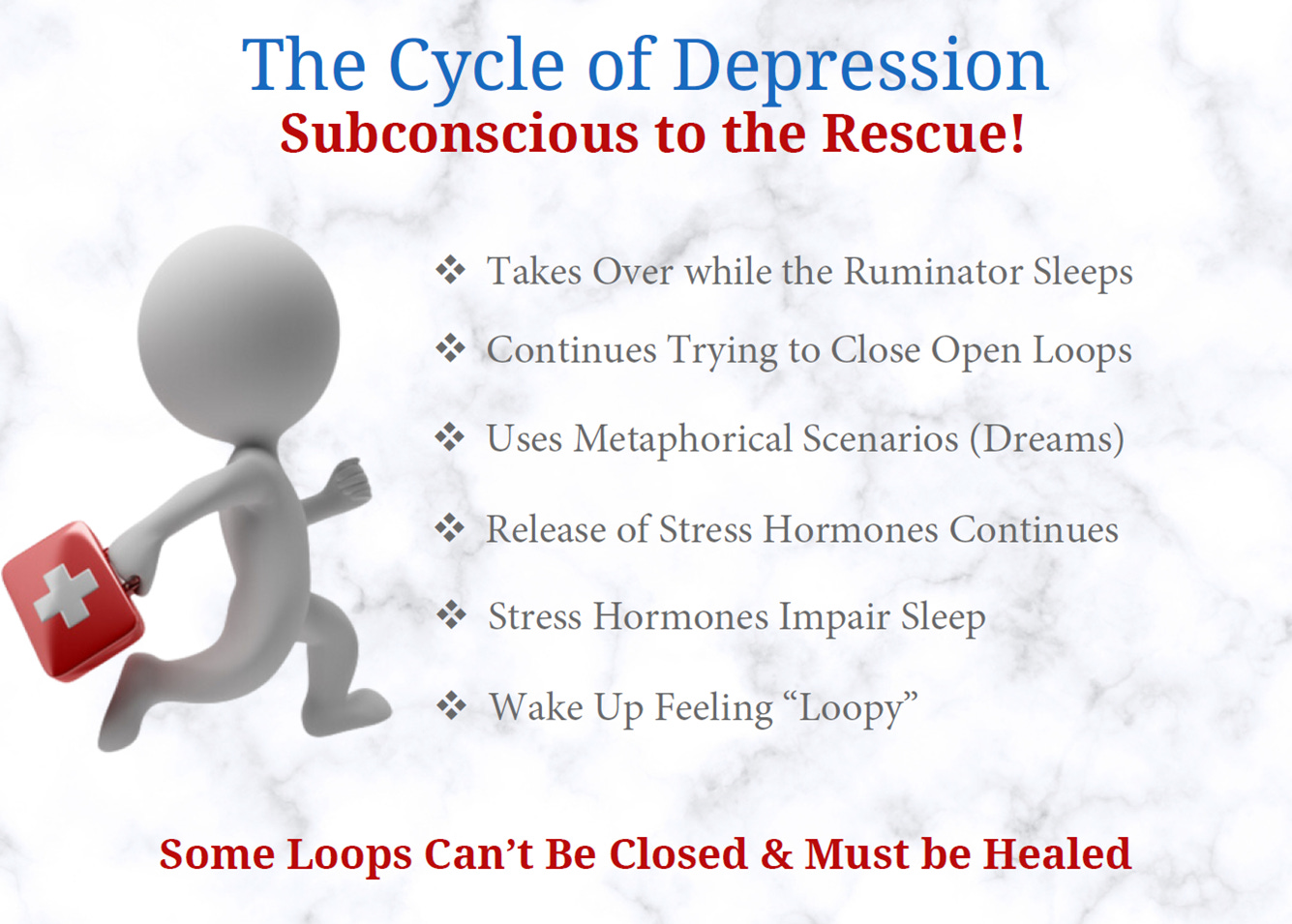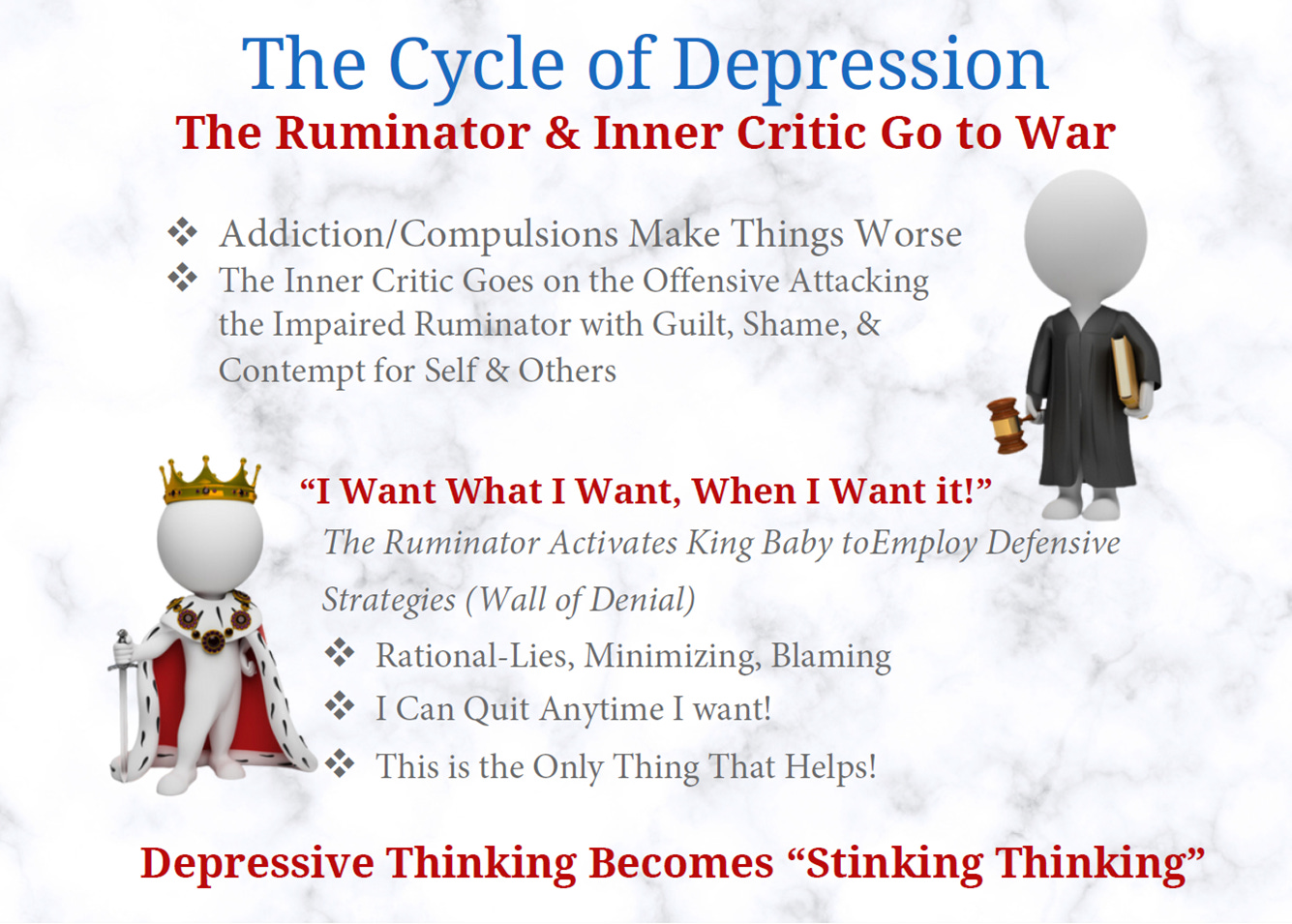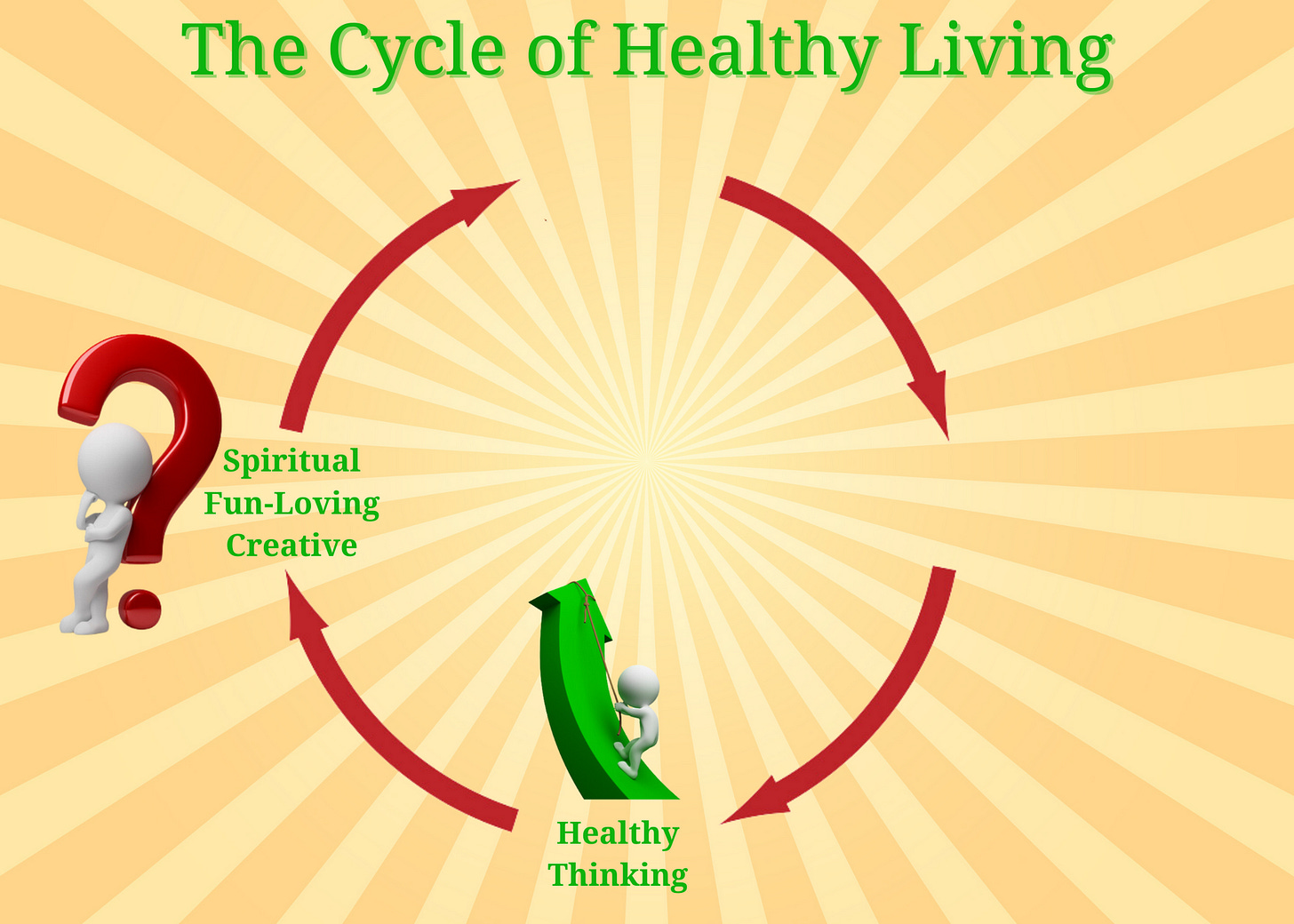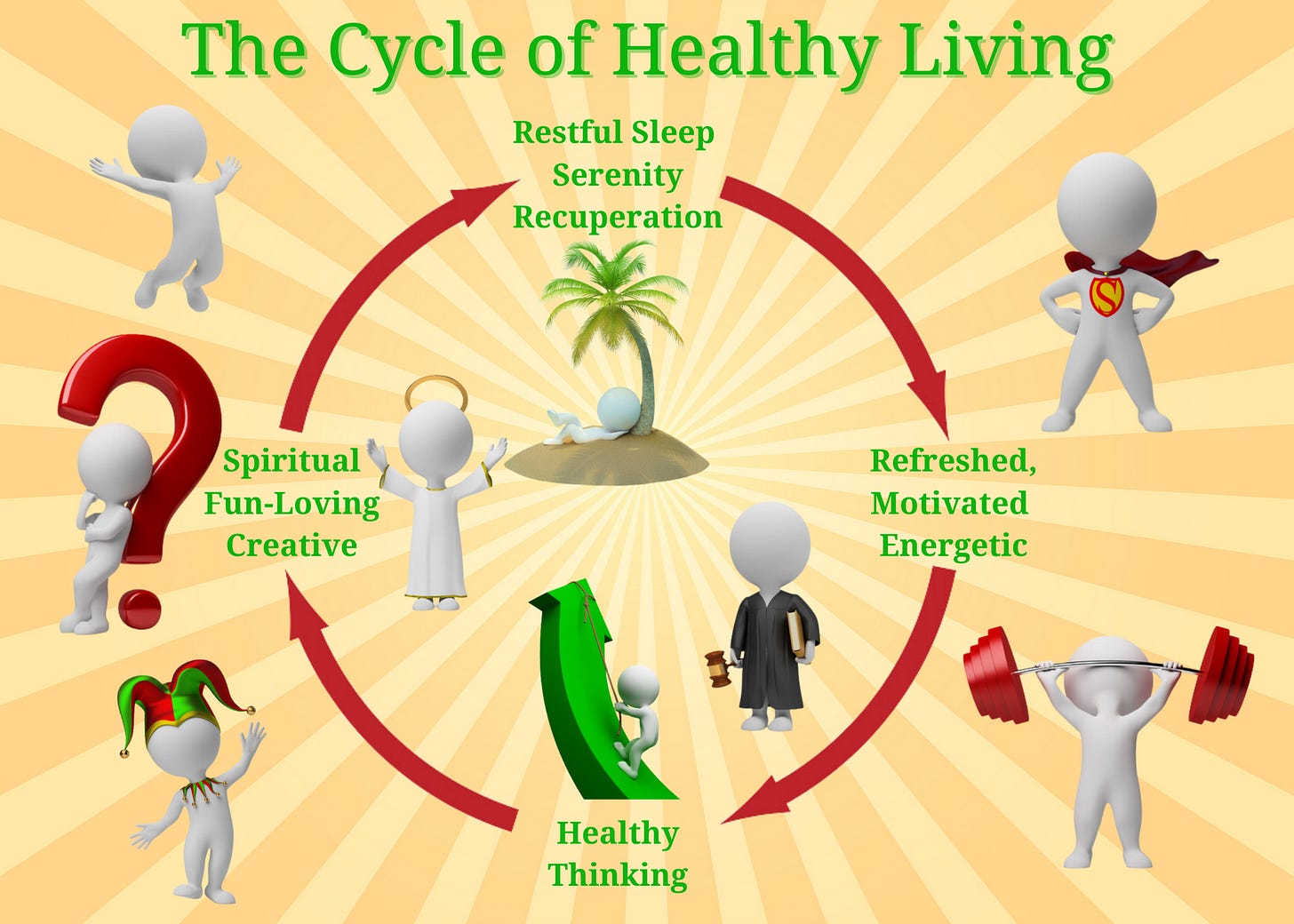Breaking Free: Ending the Cycle of Depression and Addiction
Replace "Stinking Thinking" with Healthy Coping through a Recovery Lifestyle
Welcome to an exploration of how to break the cycle of depression and addiction. This article is a deep dive into the intricate patterns that trap many in emotional pain and destructive behaviors, while offering a hopeful path toward recovery and healthy living. By understanding the neuroscience behind repetitive thoughts, the impact of childhood wounds, and the roles of inner critic and what I call the ruminator, you can begin to reclaim your life and embrace a cycle of healing and growth.
🧠 Understanding the Four Horsemen of the Autonomic Apocalypse
At the heart of many counseling episodes lie four dominant issues: depression, anxiety, addiction, and compulsion. I refer to these as the “Four Horsemen of the Autonomic Apocalypse” because they represent the most common and destructive emotional challenges people face. Their prominence is no accident, and understanding why these issues frequently appear together can shed light on how to break the cycle of depression.
Each of these “horsemen” feeds into a vicious cycle that affects the autonomic nervous system—the part of our nervous system responsible for the fight-or-flight stress response. This cycle can spiral downward into exhaustion and emotional turmoil unless interrupted by conscious healing and recovery strategies.
🔄 The Cycle of Depression: A Composite Picture
Let’s begin by examining the composite cycle of depression, which often serves as the foundation for anxiety, addiction, obsession and compulsion cycles. At the base of this cycle is depressive thinking, a pattern of distorted thoughts that trigger emotionally arousing rumination. This rumination, or repetitive negative thinking, is a significant driver of emotional distress.
One consequence of this cycle is sleep disturbance. When the mind is busy trying to solve unsolvable problems, restful sleep becomes elusive. This results in waking up tired and exhausted, which further impairs mood and energy, perpetuating the downward spiral.
💭 Magical Thinking: The Root of Depressive Thought Patterns
Many depressive thoughts stem from what I call magical thinking. These are distorted beliefs and irrational thoughts often formed in childhood as survival mechanisms. Children interpret the world through fairy tale language, which can lead to thinking patterns that no longer serve us as adults.
Here are some common types of magical thinking:
Should Thinking: “I should’ve done it differently,” “Why didn’t I…?”
Overgeneralizing: “Nothing ever works out for me,” “It always rains when I want to go to the park.”
Doing My Pain in Advance: Rehearsing disasters that rarely happen.
Mind Reading: Assuming you know what others think about you without asking.
Personalizing: Taking vague remarks personally, believing they’re about you.
Toxic Shame: Core beliefs like “I’m not good enough,” often rooted in dysfunctional family dynamics.
Catastrophizing: Imagining the worst outcomes in vivid detail.
Miserablizing: Wallowing in negative feelings and asking, “Why does this always happen to me?”
Thinking with Feelings: Believing feelings equate to facts, e.g., “If I feel stupid, I must be stupid.”
I Can’t Stand This: An exaggerated statement, as we’re usually enduring the situation to say it.
While these thinking styles may have helped children cope with their environment, they become maladaptive in adult life. They create what I call open loops—problems or threats that remain unresolved, keeping the mind stuck in a cycle of worry and rumination.
🔗 Open Loops and the Problem-Solving Brain
Open loops begin when the brain perceives a threat. Normally, the prefrontal cortex—our thinking brain—acts as a problem solver, which I call the Contemplator.
The Contemplator:
Notices a threat and assesses the situation
Creates a plan
Acts on that plan
If the plan works, that closes the loop.
This process gives us closure and peace of mind. However, many loops, especially those formed in childhood, cannot be closed because they are based on incomplete understanding or traumatic experiences. For example, a child might believe, “I’m unworthy,” based on parental neglect, a belief that doesn’t simply resolve because it must be healed.
Because these loops remain open, the problem-solving Contemplator transitions into what I call the Ruminator. Instead of closing loops, the Ruminator endlessly stews and chews on the problem, attempting to resolve threats that it cannot resolve. This repetitive cycle strengthens neural pathways that reinforce rumination, making it harder to break free.
🔄 The Ruminator and the Stress Response
When the Ruminator is triggered by perceived threats, it activates the body’s stress response. This fight-or-flight reaction floods the body with stress hormones, primarily adrenaline and cortisol. While helpful in short bursts, chronic stress hormone exposure impairs brain function and emotional regulation.
Rumination intensifies this effect, releasing even more cortisol and adrenaline, which exacerbate emotional and physical problems. The Ruminator also activates defensive parts of the self to protect against further harm, often leading to denial, blame, and other defense mechanisms.
It’s crucial to understand that many loops cannot simply be closed—they must be healed. Healing involves addressing core beliefs and attachment wounds through therapy, self-reflection, and compassionate support.
🌙 The Subconscious Mind and Sleep Disturbances
Eventually, as part of the conscious mind, the Ruminator must sleep. The subconscious mind takes over the task of processing open loops during sleep. Normally, the subconscious performs vital maintenance, such as cell regeneration and healing. However, when burdened with unresolved problems, it continues to “work” on closing these open loops via right-brain symboloic language that creates weird metaphorical scenarios called dreams.
This can result in vivid, symbolic, or even disturbing dreams that interfere with restful sleep and continues dumping stress hormones into the system. The subconscious essentially moonlights, draining energy that should be devoted to physical and mental restoration.
The result is impaired sleep or insomnia, which can manifest as difficulty falling asleep, waking up in the middle of the night, or early morning awakenings that prevent return to sleep. Poor sleep leaves us feeling groggy and mentally "loopy" in the morning, setting the stage for another day of open loops and rumination.
😴 Impaired Sleep’s Impact on Mood and Functioning
Impaired sleep doesn’t just make us tired; it directly affects our mood, energy, and ability to function. When we wake up exhausted, depressive thinking worsens, and our capacity to cope diminishes. We often experience lethargy, apathy, and a lack of motivation—sometimes to the extent that getting out of bed feels like a monumental task.
This state fuels a vicious cycle: increased stress hormones reduce serotonin levels, contributing to feelings of depression and anxiety. Many seek medical help at this point, often receiving prescriptions for SSRIs (Selective Serotonin Reuptake Inhibitors) and sleep aids.
While medications can provide some relief, they rarely address the underlying cycle. When medication and treatment fall short, feelings of helplessness and hopelessness grow, releasing even more cortisol and adrenaline, and further impairing motivation and basic needs. Relationships and self-care begin to suffer, and the negative spiral deepens.
😡 The Emergence of the Grouch and Inner Critic
As the cycle worsens, a part of ourselves I call the grouch emerges. This grouch feels helpless and angry, convinced that nothing and no one can help. It often coincides with the rise of the shame-based inner critic, which attacks the depressive thinker with harsh judgments and unrealistic expectations.
The inner critic speaks in the second person, saying things like, “You’re stupid,” or “You never do anything right.” It carries a book of shoulds in one hand and a hammer of condemnation in the other. This voice plays out disaster fantasies about the future, reinforcing feelings of shame and inadequacy.
Meanwhile, the depressive thinker echoes these messages in the first person: “I’m not good enough,” or “What’s wrong with me?” Both voices fuel the downward spiral of depressive thinking, making it harder to escape the cycle.
🤯 The Struggle of the Ruminator and the Rise of Addictions
With things spiraling out of control, the Ruminator struggles to hold everything together but becomes increasingly impaired. High cortisol levels diminish its problem-solving abilities even further, forcing it to prioritize comfort and relief at any cost.
This desperate search for relief opens the door for addictions and compulsions—the “hired guns” that temporarily soothe the pain but ultimately make the situation worse. The Ruminator, impaired and focused only on immediate comfort, cannot foresee the long-term consequences of these behaviors.
In response, the inner critic attacks the Ruminator with guilt and shame, while the Ruminator activates a defensive part of self called the King Baby The king baby’s mantra is, “I want what I want when I want it, and I want it now,” embodying impulsive, self-centered demands that justify addictive and compulsive behaviors.
Common defenses include denial, rationalizing, minimizing, and blaming: “I can quit anytime,” or “This is the only thing that helps.” This inner battle between the king baby and the inner critic often plays out externally through family and social dynamics, reinforcing destructive patterns.
⚠️ Stinking Thinking and the Crash Before Recovery
This chaotic internal landscape—marked by depressive thinking, rumination, impaired sleep, medication attempts, and the inner critic’s assault—creates what many call “hitting bottom.” The depressive thinking becomes stinking thinking, a toxic mental state that sustains addiction and depression.
Despite brief relief from addictive behaviors, the long-term outlook worsens as the Ruminator remains stuck in survival mode, overwhelmed by cortisol’s suppressive effects on executive function. The inner critic and king baby continue their tug-of-war, keeping the individual trapped in this destructive cycle.
🌅 The Silver Lining: Hitting Bottom and Reaching Out
Though hitting bottom is painful, it often serves as a turning point. This low point can motivate individuals to reach out for help, opening the door to recovery. Recovery is a process of learning a new, healthy way of living that replaces the old destructive cycle.
Transitioning into recovery can be challenging. It requires effort, sometimes including inpatient treatment to stabilize and build new coping skills. For me personally, 28 days in treatment at age 29 was a profound experience that set me on the path to healing. If you recognize these struggles in yourself, please know that help is available and recovery is possible. You won’t regret taking that first step toward healing.
🌤️ The Healthy Living Cycle: Accessing the True Self
The healthy living cycle contrasts sharply with the downward spiral of depression and addiction. Imagine the true self as the sun shining behind clouds of shame, abandonment, and survival-mode defenses. Recovery involves accessing this true self—the spiritual core that carries our values, meaning, and purpose.
Recovery teaches us to replace stinking thinking with healthy, recovery-oriented thoughts. This shift requires achieving a homeostatic balance, where stress hormones like cortisol and adrenaline are flushed out, allowing the thinking brain to return to full functioning.
When the thinking brain is restored, rumination gives way to contemplation and problem-solving. This process opens the door to spirituality, creativity, fun, and personal growth.
💡 Healthy Thinking: From Magical to Recovery-Oriented Thoughts
In recovery, we learn to challenge and refute the childhood-based magical thoughts that kept us stuck. Instead of “I’m not good enough,” we develop realistic, compassionate beliefs about ourselves.
This transformation is reflected in twelve-step programs, where the first step after abstinence is to confront and change stinking thinking. Recovery thoughts focus on hope, self-compassion, and purposeful living.
As cortisol levels decrease, the brain’s executive functions improve, enabling us to plan, solve problems, and engage meaningfully with life. This growth mode is the foundation for lasting recovery.
🌙 Restorative Sleep and Renewed Energy
Recovery also restores healthy sleep patterns. With fewer unresolved loops burdening the subconscious, the mind can focus on maintenance and healing during sleep. Dream patterns often become less distressing, allowing for more restful nights.
Waking up refreshed and energized supports motivation and healthy coping skills. This renewed vitality encourages activities like exercise and self-care, which further promote healing and resilience.
⚖️ The Inner Critic in Recovery: From Shame to Encouragement
It’s important to clarify that recovery does not aim to eliminate the inner critic. We still need this part of ourselves for discipline and guidance. The goal is to transform the inner critic from a shaming, harsh voice into a mentor or sponsor—a supportive guide that helps us maintain healthy boundaries and habits.
This means toning down shame-based motivation, which often triggers stinking thinking, and embracing encouragement and constructive feedback. Therapy, sponsorship, literature, and community support can help us find this healthy balance.
🎉 Rediscovering Joy and Spiritual Connection
One of the greatest rewards of recovery is the ability to enjoy life without reliance on substances or compulsive behaviors. As we heal, we reconnect with our natural, fun-loving selves and discover new, healthy ways to experience joy.
Perhaps most importantly, recovery reconnects us with the true spiritual part of ourselves—the part connected to a higher power, carrying our spiritual values and beliefs. This connection provides meaning, purpose, and a sense of harmony in our inner world.
In this state of growth and self-actualization, all parts of our being work together toward common goals, creating a fulfilling and balanced life.
🌈 Conclusion: Your Path to Breaking the Cycle of Depression
Breaking the cycle of depression and addiction is a challenging but deeply rewarding journey. Understanding the roles of depressive thinking, rumination, the inner critic, and addictive behaviors provides clarity on why we get stuck and how to move forward.
Recovery is not just about stopping destructive behaviors—it’s about transforming the entire internal ecosystem to support health, growth, and spiritual connection. It requires patience, effort, and often professional support, but millions have found hope and healing through this path.
If you or someone you know is struggling with these issues, please reach out. Help is available, and recovery is possible. You don’t have to stay trapped in the cycle of depression. There is a way to break free and find peace, purpose, and joy.
Feel free to connect with me through my email or chat programs on my websites. Let’s work together to get you connected with support in your area and begin your journey toward recovery.
Remember: Breaking the cycle of depression starts with understanding and ends with healing. Your true self is the sun shining behind the clouds—let recovery help the sun shine through.



